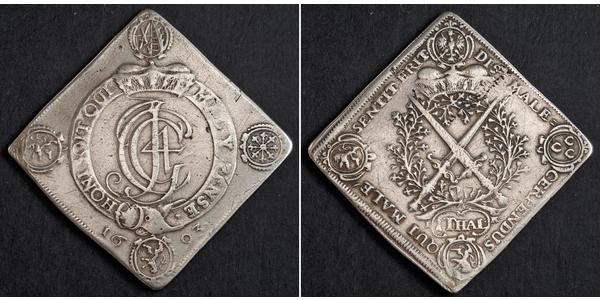(sold for $430.0)
1693, Saxony, John George IV. Silver "Order of the Garter" Klippe Thaler Coin.
Mint Year: 1693 Mint Place: Dresden Reference: Davenport 7649, Schnee 977, Claus & Kahn 692, KM-. R! Condition: Welding scars on edge (this coin was once used as a pendant), scratches, otherwise VF! Denomination: Klippe Thaler - Initiation of Johann Georg into the Order of the Garter during 1693. Weight: 24.98gm Diameter: 53mm Material: Silver
Obverse: Ducal cap above monogram ("JG 4") of John George IV within garter band inscribed with motto (HONI SOIT QUI MAL Y PENSE = "Shame on him who thinks ill of it!"). Comment: Four oval coat-of-arms in corners, date (16-93) split below! Legend: IOH . GEORG . IV . D . G . DVX . SAX . I . C . M . A . & . W .
Reverse: Ducal crown on wreathed swords in saltire. Value (1 THAL) below. Four oval coats of arms in four corners. Legend: DIS : MALE : CERPENDUS QUI MALE SENTIT ERIT •
This klippe commemorates the election of Johann Georg IV into the Order of the Garter, an exclusive society of knights founded around 1348 by Edward III of England. The motto surrounding the monogram on the obverse, HONI SOIT QUI MAL Y PENSE, can be loosely translated as "Shame on him who thinks ill of it." The precise details surrounding the origin of the order are not known, but several myths attempt to explain it. All of these legends involve a garter band, which has become a symbol of the society. This garter, inscribed with the order's motto, is still worn by members during official ceremonies.
John George IV (Dresden, 18 October 1668 – Dresden, 27 April 1694) was Elector of Saxony from 1691 to 1694.
He was the eldest son of the Elector John George III and Anna Sophie of Denmark.
John George succeeded his father as Elector when he died, on 12 September 1691.
At the beginning of his reign his chief adviser was Hans Adam von Schöning, who counselled a union between Saxony and Brandenburg and a more independent attitude towards the emperor. In accordance with this advice certain proposals were put before Leopold I to which he refused to agree; and consequently the Saxon troops withdrew from the imperial army, a proceeding which led the chagrined emperor to seize and imprison Schöning in July 1692. Although John George was unable to procure his minister's release, Leopold managed to allay the elector's anger, and early in 1693 the Saxon soldiers rejoined the imperialists.
In Leipzig on 17 April 1692, John George married Eleonore Erdmuthe of Saxe-Eisenach, Dowager Margravine of Brandenburg-Ansbach. The young Elector was forced to marry by his mother, the Dowager Electress Anna Sophie, supposedly to produce legitimate heirs to the Electorate. The real reason for the marriage was to end the liaison between John George and Magdalena Sibylla of Neidschutz.
John George III, the late Elector had tried to separate the lovers, perhaps because he was aware of a close blood relationship between them — for Magdalena Sybilla may have been his own illegitimate daughter by Ursula Margarethe of Haugwitz, and therefore John George IV's half-sister. By order of the Elector, Ursula had married Colonel Rudolf of Neidschutz, who officially appears as the father of her daughter.
John George may never have known of his possible blood relationship to Magdalena Sibylla or regarded the claim as a rumor spread by ill-wishers. Immediately after he assumed the Electorate, he openly lived with her, and she became the first ever Official Mistress (Favoritin) of an Elector of Saxony.
The Electress, Eleonore Erdmuthe, humiliated every day since her wedding, was relegated to the Hofe (the official residence of the Elector). John George moved into another palace with Magdalena Sybilla.
Desperate to marry his mistress, John George tried to murder his wife, but was prevented by his younger brother, Frederick August. When John George tried to stab Eleonore with a sword, the unarmed Frederick turned the impact away with his hand, leaving him with a lifelong handicap.
After a substantial bribe from the Elector, on 20 February 1693 Magdalene Sybille was created Countess of Rochlitz (Grafïn von Rochlitz) by Imperial Decree. Shortly before, she gave birth the only daughter of the couple, Wilhelmina Maria.
But the happiness ended soon: Magdalene Sybille contracted smallpox and died on 4 April 1694, in the arms of the Elector, who was also infected with the disease.
John George died twenty-three days later, on 27 April. He was buried in the Freiberg Cathedral.
Because he died without legitimate issue—Electress Eleonore suffered two miscarriages during their marriage, in August 1692 and February 1693—he was succeeded as Elector by his brother Frederick Augustus I (king of Poland as Augustus II of Poland). The new Elector took the guardianship of the little orphan Wilhelmina Maria, who was raised in the court. He acknowledged the girl as his niece and gave her a dowry when she was married to a Polish Count.
Only 1$ shipping for each additional item purchased!

|
Posted by:
anonymous 2021-01-13 |
1/12 Thaler Duchy of Mecklenburg-Schwerin (1352-1918) Billon
group has 3 coins / 3 prices
⇑







-300-150-Obxhf7_DVzkAAAGMhuiS9kWQ.jpg)






